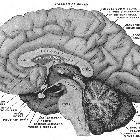Hydrocephalus communicans




Communicating hydrocephalus is a type of hydrocephalus where CSF is able to leave the ventricular system.
Terminology
Communicating hydrocephalus is commonly used as the opposite of obstructive hydrocephalus which leads to much unnecessary confusion, as most causes of communicating hydrocephalus do have an element of obstruction to normal CSF flow / absorption. For a discussion of this terminology please refer to the more general article on hydrocephalus.
Epidemiology
The demographics of affected patients will depend on the underlying causes.
Pathology
The cause of hydrocephalus in such cases is variable and can either be due to reduced absorption of CSF (due to obstruction of CSF flow through the subarachnoid space or at the level of the arachnoid granulations (and probably perivascular spaces: see glymphatic pathway) or due to overproduction of CSF. The latter is very uncommon, and only really seen in choroid plexus papillomas.
Etiology
- subarachnoid hemorrhage (SAH)
- meningitis
- normal pressure hydrocephalus (NPH)
- leptomeningeal infiltration by tumor
- as a post-operative complication
Radiographic features
Communicating hydrocephalus can be challenging to distinguish from ventricular enlargement seen in patients with ex vacuo dilatation of the ventricles due to parenchymal volume loss. The third ventricle and temporal horns of the lateral ventricles are key to the diagnosis, as even in patients with significant ex vacuo dilatation, these regions are usually relatively preserved .
Additionally often there is crowding of the sulci at the vertex and disproportionate widening of the Sylvian cisterns. See also: hydrocephalus versus atrophy.
The radiographic features of normal pressure hydrocephalus (NPH) and choroid plexus papillomas are discussed separately.
Treatment and prognosis
Unlike many cases of obstructive noncommunicating hydrocephalus, where an endoscopic third ventriculostomy can bypass the site of obstruction, in communicating hydrocephalus patients usually require CSF shunting, most commonly with a VP shunt.
Siehe auch:
- Hydrocephalus
- Subarachnoidalblutung
- Corpus callosum
- Normaldruckhydrozephalus
- Meningitis
- dritter Ventrikel
- Tectumgliom
- Seitenventrikel
- Aquäduktstenose
- vierter Ventrikel
- ventrikuloperitonealer Shunt
- transependymales Ödem
- hydrocephalus versus atrophy
- third ventriculostomy
- pädiatrische Erkrankungen des Liquorsystems
- Magendie
- Luschka

 Assoziationen und Differentialdiagnosen zu Hydrocephalus communicans:
Assoziationen und Differentialdiagnosen zu Hydrocephalus communicans:












